Description
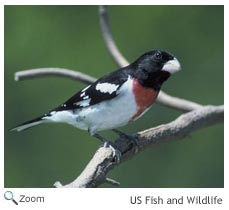 The rose-breasted grosbeak is 7-8 inches in length with a wingspan of 11-13 inches. It has a strong, pale pinkish-white, cone-shaped bill. The male has a black head, wings, and back; a white belly and rump; and a red breast and underwings. The female has a brown back, a cream colored breast with brown streaks, and a white belly and rump. She has a white stripe over her eyes and yellow underwings. The rose-breasted grosbeak is 7-8 inches in length with a wingspan of 11-13 inches. It has a strong, pale pinkish-white, cone-shaped bill. The male has a black head, wings, and back; a white belly and rump; and a red breast and underwings. The female has a brown back, a cream colored breast with brown streaks, and a white belly and rump. She has a white stripe over her eyes and yellow underwings.
Range 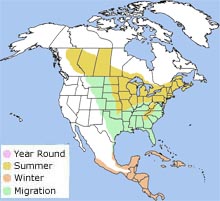 The rose-breasted grosbeak breeds
from northeastern British Columbia east to Nova Scotia and south to North Dakota, Oklahoma, Missouri, Ohio, West Virginia, and New Jersey.
The rose-breasted grosbeak is a neotropical migrator and winters
from southern Mexico to northern South America and the Caribbean. The rose-breasted grosbeak breeds
from northeastern British Columbia east to Nova Scotia and south to North Dakota, Oklahoma, Missouri, Ohio, West Virginia, and New Jersey.
The rose-breasted grosbeak is a neotropical migrator and winters
from southern Mexico to northern South America and the Caribbean. |
|
Habitat
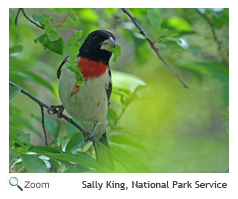 The rose-breasted grosbeak breeds in deciduous, and mixed forests and woodlands with open fields and in old orchards. It winters in tropical forests in Mexico, Central America, northern South America, and the Caribbean. The rose-breasted grosbeak breeds in deciduous, and mixed forests and woodlands with open fields and in old orchards. It winters in tropical forests in Mexico, Central America, northern South America, and the Caribbean. Diet
The rose-breasted grosbeak forages in tress for seeds, fruits, and buds. It also eats insects.
Life Cycle
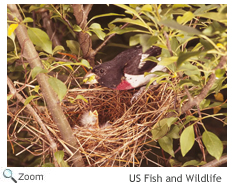 The female rose-breasted grosbeak lays 1-5 eggs in a
loose cup-shaped nest of twigs and grass. The nest is made in a tree or bush. Both parents incubate the eggs for 12-14 days. Both the male and the female feed the chicks. The chicks fledge when they are 9-12 days old, but stay with their parents for a few more weeks. The female rose-breasted grosbeak lays 1-5 eggs in a
loose cup-shaped nest of twigs and grass. The nest is made in a tree or bush. Both parents incubate the eggs for 12-14 days. Both the male and the female feed the chicks. The chicks fledge when they are 9-12 days old, but stay with their parents for a few more weeks.
BehaviorThe rose-breasted grosbeak's song is similar to the song of the American robin, but it is a little faster.
|

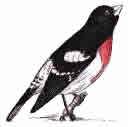

 The rose-breasted grosbeak breeds
from northeastern British Columbia east to Nova Scotia and south to North Dakota, Oklahoma, Missouri, Ohio, West Virginia, and New Jersey.
The rose-breasted grosbeak is a neotropical
The rose-breasted grosbeak breeds
from northeastern British Columbia east to Nova Scotia and south to North Dakota, Oklahoma, Missouri, Ohio, West Virginia, and New Jersey.
The rose-breasted grosbeak is a neotropical 
